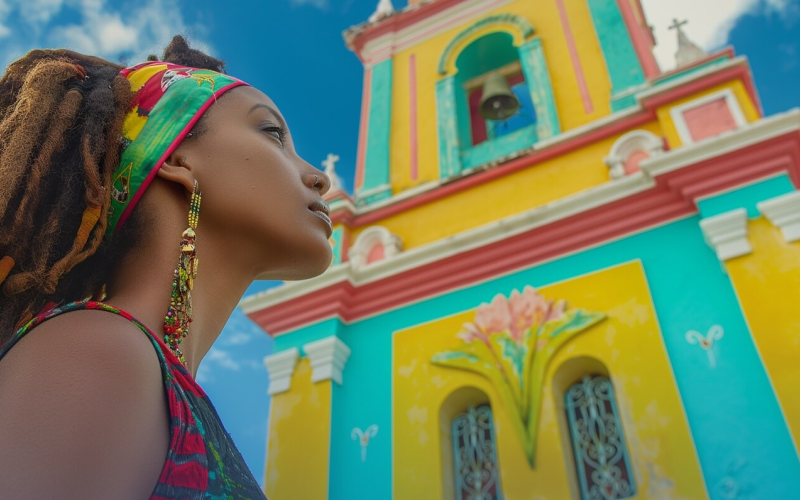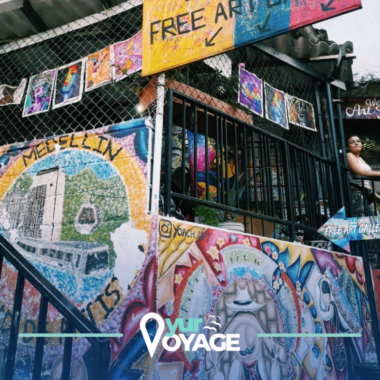Topics
South America, a continent bursting with vibrancy, offers a tapestry of cultures that is as diverse as its landscapes. From the sultry rhythms of the Argentine Tango to the ancient ruins of the Incan Empire, every corner tells a story, every city is a testament to the past and present coming together in a beautiful symphony. This guide is dedicated to travelers seeking not just a journey, but an immersion into the heart of South America’s cultural richness. Here, we uncover the Top 7 Cultural Cities in South America for Travelers, a curated list for those who wish to experience the soul of this magnificent continent.
What Makes a City a “Cultural Hub” in South America?
When we talk about a city being a cultural hub, we’re referring to its capacity to showcase a blend of historical, artistic, and social elements that are unique to its region and have a significant impact on not only its own identity but also on the broader cultural landscape of South America. These cities are living museums, echoing the past through their cobblestone streets, colonial architecture, and ancient ruins, while simultaneously pulsating with contemporary life through their art, music, and festivals.
A cultural city in South America is one where every corner has a story, where the local music, food, and traditions are not just attractions but ways of life that invite travelers to look, listen, and engage. Whether it’s through experiencing a traditional dance, visiting a historic site, or participating in a local festival, these cities offer a gateway to understanding the rich tapestry of South American culture.
Criteria for Selecting the Top Cultural Cities
Selecting the top cultural cities in South America is no small feat, given the continent’s vast cultural diversity. The cities chosen excel in several key areas:
- Historical Significance: Cities with a rich history, evident in their monuments, museums, and neighborhoods, offer a deep dive into the past.
- Cultural Diversity and Inclusivity: Places where a melting pot of cultures coexists, offering a diverse range of experiences to visitors.
- Richness in Arts, Music, and Festivals: Cities that are vibrant with the arts, whether through street art, galleries, concerts, or cultural celebrations.
- Architectural Uniqueness: Locations where the architecture tells the story of the city’s evolution from ancient times to modern days.
- Traveler Recommendations: Feedback from both locals and international travelers highlighting the city’s cultural offerings and welcoming atmosphere.
Each city on our list has been selected for its ability to offer an immersive cultural experience, providing travelers with a meaningful connection to the heart and soul of South America.
Let’s delve into the essence of each of these cities, exploring their historical roots, cultural highlights, and the unique experiences they offer to those who wander through their streets.
The Top 7 Cultural Cities in South America for Travelers
Buenos Aires, Argentina – The Tango Capital
Buenos Aires stands as a beacon of culture in South America, renowned for its deep-rooted tradition of Tango, which is much more than a dance—it’s a cultural heritage that tells the story of the city’s history. Walking through the streets of Buenos Aires, travelers are enveloped in a world where the past and present coexist in harmony.
Historical and Cultural Significance
Buenos Aires is a city where every neighborhood tells a different story. From the colorful houses of La Boca to the elegant, Parisian-style buildings in Recoleta, the city is a mosaic of architectural styles and cultural influences. The Teatro Colón, one of the most important opera houses in the world, is a testament to the city’s rich musical heritage.
Tango: A Cultural Journey
The soul of Buenos Aires is best experienced through Tango. Visitors can take tango classes, attend milongas (tango social dances), or enjoy a tango show in venues scattered throughout the city. The dance is a UNESCO Intangible Cultural Heritage and is celebrated every year during the Buenos Aires Tango Festival.
Cultural Festivals and Events
Buenos Aires hosts numerous cultural events throughout the year, including the Buenos Aires International Book Fair and the Buenos Aires International Festival of Independent Cinema. These events showcase the city’s vibrant arts scene and its role as a cultural hub in South America.
Travel Tips for Buenos Aires
- Best Time to Visit: Spring (September to November) and fall (March to May) offer pleasant weather and numerous cultural events.
- Transportation: The city’s public transport system (Subte, buses) is extensive and affordable. However, walking is the best way to explore the diverse neighborhoods.
- Cultural Etiquette: Embrace the local custom of greeting with a kiss on the cheek; it’s a sign of warmth and friendliness.
Buenos Aires is not just a city; it’s an experience that captivates the heart through its music, dance, and spirit. It’s a place where every traveler finds a piece of history to connect with and a rhythm that moves them.
Rio de Janeiro, Brazil – The Carnival City
Rio de Janeiro is a city that pulsates with the rhythms of samba and bossa nova, a place where the vibrancy of Brazilian culture is on full display. Known worldwide for its breathtaking landscapes, Rio also boasts a rich cultural heritage that draws visitors from all corners of the globe.
Historical and Cultural Significance
The city’s architecture reflects a blend of colonial, modernist, and contemporary influences, with iconic landmarks like the Christ the Redeemer statue overlooking the city and the Sugarloaf Mountain providing stunning vistas. The Historic Center, with its colonial buildings and cobblestone streets, offers a glimpse into Rio’s past.
Carnival: A Global Phenomenon
Rio’s Carnival is the epitome of Brazilian festivity, a dazzling spectacle of color, music, and dance. The Sambadrome parades, featuring elaborate floats and costumes from the city’s numerous samba schools, are the highlight of the festival. Beyond the parades, street parties (blocos) invite everyone to dance and celebrate in what is truly a citywide party.
Cultural Landmarks and Activities
- The Santa Teresa neighborhood, with its bohemian vibe, art studios, and eclectic bars, is a must-visit for culture enthusiasts.
- Museums like the Museum of Tomorrow and the Rio Art Museum (MAR) showcase Brazil’s commitment to celebrating its cultural achievements and addressing global challenges.
- Beach culture is integral to Rio’s identity, with Copacabana and Ipanema being not just beautiful beaches but centers of social life and leisure.
Travel Tips for Rio de Janeiro
- Best Time to Visit: The Carnival season (February or March, depending on the year) is an unforgettable experience, but the city is vibrant year-round.
- Safety: While Rio is a city of unparalleled beauty, it’s wise to stay aware of your surroundings, especially in crowded places.
- Cultural Etiquette: Engage with locals (Cariocas) in their laid-back and friendly manner, and don’t be shy to try your hand (or feet) at samba dancing.
Rio de Janeiro offers an immersive cultural experience, from its world-renowned Carnival to its stunning natural scenery and lively neighborhoods. It’s a city where the joy of life is celebrated at every turn, making it an essential destination for travelers seeking to explore the cultural cities of South America.
Cusco, Peru – The Gateway to the Incan Empire
Cusco serves as the heart of the Incan legacy, a city where ancient ruins meet colonial grandeur. This former capital of the Incan Empire is not just a stepping stone to Machu Picchu but a vibrant cultural city in its own right, offering a deep dive into Peru’s rich history and traditions.
Historical and Cultural Significance
Cusco’s streets and squares are lined with remnants of both Incan architecture and Spanish colonial buildings, creating a unique blend that has earned the city a UNESCO World Heritage designation. Sites like Sacsayhuamán and the Qorikancha (Temple of the Sun) offer insights into the sophisticated engineering and astronomical knowledge of the Incas.
Gateway to Machu Picchu
While Cusco is often seen as the gateway to Machu Picchu, the sacred Incan city in the clouds, it’s also the starting point for exploring other less-visited but equally fascinating sites such as the Sacred Valley, Ollantaytambo, and Pisac. These sites provide a deeper understanding of the Incan civilization’s complexity and its harmonious relationship with nature.
Indigenous Culture and Traditions
- Cusco is a living museum of Peruvian culture, where indigenous traditions are still very much alive. The city’s markets, like the famous San Pedro Market, offer a colorful array of local crafts, textiles, and foods.
- Traditional festivals such as Inti Raymi (Festival of the Sun) and Corpus Christi celebrate Incan and Christian traditions, showcasing the syncretism that defines Peruvian culture.
- Culinary experiences in Cusco provide a taste of the Andean diet, featuring native ingredients like quinoa, potatoes, and alpaca meat.
Travel Tips for Cusco
- Best Time to Visit: The dry season from May to October offers clear skies and cooler temperatures, ideal for exploring archaeological sites.
- Altitude Sickness: Cusco sits at over 11,000 feet above sea level. Take it easy on your first few days to acclimate and stay hydrated.
- Cultural Respect: When visiting sacred sites or participating in local festivals, show respect for indigenous traditions and customs. Always ask permission before taking photos of people.
Cusco is more than just a city; it’s a portal to the past, offering visitors a profound connection to the Incan empire and the vibrant culture that has flourished in its shadow. For travelers eager to explore the cultural cities of South America, Cusco represents an essential and unforgettable journey into the heart of Andean heritage.
Cartagena, Colombia – A Caribbean Jewel
Cartagena, with its colorful colonial architecture, tropical climate, and vibrant street life, stands as a jewel of the Caribbean coast. This UNESCO World Heritage site is not just a testament to the historical significance of the region but also a lively center of Afro-Caribbean culture, music, and cuisine.
Historical and Cultural Significance
The heart of Cartagena lies within its walled city, where narrow cobblestone streets lead to charming plazas, cathedrals, and palaces dating back to the colonial era. The fortifications, including the imposing Castillo de San Felipe de Barajas, speak to the city’s strategic importance in the Caribbean and its history of piracy, colonialism, and independence.
Cultural Fusion
Cartagena’s culture is a rich tapestry woven from indigenous, African, and Spanish threads. This fusion is evident in the city’s music, dance, and festivals. Cumbia and Mapalé, traditional dances with African and indigenous roots, are celebrated during the city’s numerous festivals, including the Cartagena International Music Festival and the Hay Festival.
Culinary Delights and Traditional Dishes
Cartagena’s culinary scene is a reflection of its cultural diversity, offering a delicious blend of seafood, tropical fruits, and traditional dishes like arepas, coconut rice, and fried fish. The city’s street food and upscale restaurants alike provide a taste of the Caribbean that is both exotic and comforting.
Travel Tips for Cartagena
- Best Time to Visit: The dry season from December to April offers sunny days and cooler evenings, perfect for exploring the city and enjoying the beaches.
- Explore Beyond the Old Town: While the walled city is a must-see, neighborhoods like Getsemaní offer a more local experience with vibrant street art, cafes, and nightlife.
- Stay Hydrated: Cartagena’s tropical climate means it can get quite hot. Always carry water, wear sunscreen, and seek shade during the midday sun.
Cartagena invites travelers to step into a world where history and modernity dance to the rhythms of the Caribbean. Its cultural richness, architectural beauty, and lively atmosphere make it an essential destination for anyone exploring the cultural cities of South America.
Santiago, Chile – A Melting Pot of Modernity and Tradition
Santiago, nestled in the central valley of Chile with the majestic Andes as its backdrop, offers a unique blend of modernity and tradition. This vibrant capital city is not only the economic and political center of Chile but also a cultural heartland, where contemporary art and ancient traditions coexist.
Historical and Cultural Significance
Santiago’s rich history is visible in its diverse architecture, from colonial-era churches to modern skyscrapers. The Plaza de Armas, the city’s historic center, is surrounded by important landmarks like the Cathedral of Santiago and the National History Museum. Meanwhile, the Palacio de La Moneda, the presidential palace, reflects the country’s political past and present.
Artistic Neighborhoods and Cultural Institutions
- Bellavista and Lastarria are two neighborhoods known for their bohemian flair, street art, and cultural venues. Here, visitors can explore art galleries, theaters, and lively cafes that showcase the creative spirit of Santiago.
- Museo Chileno de Arte Precolombino offers a comprehensive look at the indigenous cultures of the Americas before European colonization.
- The La Moneda Cultural Center, located beneath the presidential palace, hosts art exhibitions, film screenings, and cultural events that are open to the public.
Wine Culture and Vineyard Tours
Chile is renowned for its wine, and Santiago serves as a gateway to some of the country’s most prestigious vineyards. Tours of the Maipo, Casablanca, and Colchagua valleys allow visitors to taste world-class wines and learn about the winemaking process set against the picturesque Chilean landscape.
Travel Tips for Santiago
- Best Time to Visit: Spring (September to November) and fall (March to May) offer mild temperatures and clear skies, ideal for outdoor activities and vineyard tours.
- Public Transportation: Santiago’s metro system is one of the most modern in Latin America, providing an efficient way to navigate the city.
- Cultural Etiquette: Chileans are known for their hospitality. A basic understanding of Spanish can go a long way in enriching your experience, as it opens up more authentic interactions with locals.
Santiago captivates travelers with its dynamic mix of cultural heritage and modern innovation. Whether you’re exploring its historic sites, enjoying the vibrant arts scene, or sipping on fine Chilean wines, Santiago offers a multifaceted experience that reflects the diverse soul of South America.
Santiago, Chile – A Melting Pot of Modernity and Tradition
Santiago, nestled in the central valley of Chile with the majestic Andes as its backdrop, offers a unique blend of modernity and tradition. This vibrant capital city is not only the economic and political center of Chile but also a cultural heartland, where contemporary art and ancient traditions coexist.
Historical and Cultural Significance
Santiago’s rich history is visible in its diverse architecture, from colonial-era churches to modern skyscrapers. The Plaza de Armas, the city’s historic center, is surrounded by important landmarks like the Cathedral of Santiago and the National History Museum. Meanwhile, the Palacio de La Moneda, the presidential palace, reflects the country’s political past and present.
Artistic Neighborhoods and Cultural Institutions
- Bellavista and Lastarria are two neighborhoods known for their bohemian flair, street art, and cultural venues. Here, visitors can explore art galleries, theaters, and lively cafes that showcase the creative spirit of Santiago.
- Museo Chileno de Arte Precolombino offers a comprehensive look at the indigenous cultures of the Americas before European colonization.
- The La Moneda Cultural Center, located beneath the presidential palace, hosts art exhibitions, film screenings, and cultural events that are open to the public.
Wine Culture and Vineyard Tours
Chile is renowned for its wine, and Santiago serves as a gateway to some of the country’s most prestigious vineyards. Tours of the Maipo, Casablanca, and Colchagua valleys allow visitors to taste world-class wines and learn about the winemaking process set against the picturesque Chilean landscape.
Travel Tips for Santiago
- Best Time to Visit: Spring (September to November) and fall (March to May) offer mild temperatures and clear skies, ideal for outdoor activities and vineyard tours.
- Public Transportation: Santiago’s metro system is one of the most modern in Latin America, providing an efficient way to navigate the city.
- Cultural Etiquette: Chileans are known for their hospitality. A basic understanding of Spanish can go a long way in enriching your experience, as it opens up more authentic interactions with locals.
Santiago captivates travelers with its dynamic mix of cultural heritage and modern innovation. Whether you’re exploring its historic sites, enjoying the vibrant arts scene, or sipping on fine Chilean wines, Santiago offers a multifaceted experience that reflects the diverse soul of South America.
Salvador, Brazil – The Heart of Afro-Brazilian Culture
Salvador, the capital of Bahia state, is a city where the rhythm of the drum beats in sync with the heart. It’s a place where Afro-Brazilian culture is celebrated, preserved, and lived daily, making it a unique and vibrant cultural city in South America. Salvador’s rich history, colorful colonial architecture, and lively festivals offer a deep dive into the soul of Brazilian heritage.
Historical and Cultural Significance
Salvador was the first colonial capital of Brazil and is one of the oldest cities in the Americas. The Historic Center of Salvador, known as Pelourinho, is a UNESCO World Heritage site characterized by its pastel-colored buildings, baroque churches, and cobblestone streets. This area serves as a living museum, showcasing the city’s colonial past and its African heritage.
Afro-Brazilian Culture and Traditions
Salvador is the cradle of many Afro-Brazilian traditions that have shaped Brazilian culture at large. The city is renowned for its:
- Capoeira, a martial art that combines elements of dance, acrobatics, and music, originating from African slaves.
- Candomblé, an Afro-Brazilian religion that worships Orishas (deities), offering a unique insight into the spiritual life of the community.
- Samba-reggae, a music genre that emerged from the blocos afros (Afro-Brazilian Carnival groups) of Salvador, reflecting the city’s vibrant music scene.
Culinary Delights and Traditional Dishes
Salvador’s cuisine is a testament to its cultural melting pot, blending indigenous, Portuguese, and African flavors. Traditional dishes like moqueca baiana (a seafood stew), acarajé (fried bean patties), and vatapá (a spicy seafood or chicken dish) are not just meals but expressions of the city’s rich cultural heritage.
Travel Tips for Salvador
- Best Time to Visit: The city comes alive during Carnival (February or March, depending on the year), but the weather is pleasant for travel year-round.
- Cultural Etiquette: Salvador is a city of warm, welcoming people. Engaging with locals and participating in cultural experiences will enrich your visit. Respect for religious and cultural practices is crucial, especially when visiting Candomblé terreiros (temples) or participating in Capoeira circles.
- Safety: As with many large cities, it’s important to be mindful of your surroundings, especially at night. Stick to well-traveled areas and take taxis or rideshares when moving around in the evening.
Salvador offers an unparalleled exploration of Afro-Brazilian culture, from its historic streets to its lively music and dance, making it a must-visit for travelers seeking to immerse themselves in the cultural diversity of South America.
Having completed our exploration of the Top 7 Cultural Cities in South America for Travelers, we’ve delved into the unique aspects that make each city a beacon of culture, history, and tradition. These destinations offer more than just picturesque landscapes; they provide a window into the soul of South America, showcasing the diversity, resilience, and vibrancy of its people.
As you plan your journey to these cultural hubs, remember that the essence of travel lies in connection—connecting with the places you visit, the people you meet, and the stories you uncover. Each city, from Buenos Aires to Salvador, stands ready to offer its own unique lessons and experiences, contributing to the tapestry of memories you’ll weave along your travels.
Planning Your Cultural Journey to South America
Embarking on a cultural journey to South America involves more than booking flights and accommodations; it’s about preparing to immerse yourself in the rich tapestry of experiences each city offers. Here are some final tips to help you make the most of your journey:
- Research and Respect: Take time to learn about the cultural norms and traditions of each destination. Showing respect and openness to local customs will greatly enhance your interactions and experiences.
- Language Preparation: While Spanish is widely spoken across most of South America, Portuguese is the language of Brazil. Knowing basic phrases in each language can open doors and foster connections with locals.
- Embrace the Unexpected: Part of the beauty of travel lies in the spontaneous and unforeseen moments. Be open to changing your plans based on recommendations from locals or new discoveries.
Conclusion
Our guide to the Top 7 Cultural Cities in South America for Travelers is just the beginning of what promises to be a remarkable journey. From the historical depths of Cusco and Quito to the vibrant streets of Rio de Janeiro and Salvador, each city offers a unique gateway to understanding the continent’s past and present. Whether you’re drawn to the arts, history, cuisine, or the natural beauty that frames these cities, South America’s cultural capitals are sure to leave a lasting impression on your heart and mind.
We hope this guide inspires you to explore, discover, and fall in love with the rich cultural heritage of South America. Safe travels, and may your journey be as enriching as the destinations themselves.
Thank you for allowing us to be a part of your travel planning process. We can’t wait to hear about the memories you’ll create in these incredible cultural cities of South America.




